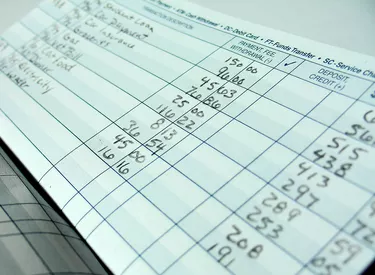
Whether you're writing a check or making ATM withdrawals, keeping a current balance in your checking account is vital. You risk overdraft fees if you don't know the available balance in your checking account.
But how do you keep track of your checking account's current balance? That's where a checkbook register comes in handy.
Video of the Day
Video of the Day
What Is a Checkbook Register?
A checkbook register is a record that tracks transactions and allows you to keep a correct checking account balance. It also keeps track of when your paper checks clear the bank or credit union.
The checkbook register allows you to avoid non-sufficient funds and, therefore, overdraft fees.
What Are the Fields of a Check Register?
The check register is typically a ruled book in the shape of a check. It has seven columns with different fields. Your financial institution should provide one with your checkbook. But if your bank or credit union doesn't provide one, you can purchase one online. There are seven fields you need to use when balancing a checkbook. They include, in order across the page:
- check number
- date
- transaction description
- payment/fee/withdrawal
- checkmark
- deposit credit
- current balance
Filling out all the fields is important. This will keep you from ending up with the wrong amount in your checkbook register.
How to Fill Out a Checkbook Register
- Always write the check number first, and then write the date the check was written.
- Next, you'll need to enter a description of who the check was written to (the payee), and for what service or product.
- Following the payee, write the amount of the check. Don't worry about the checkmark at this point – that will come when you go to balance your checkbook.
- After the checkmark column comes the deposit. This is where you write the deposit amount. It could be a direct deposit from your job or some other funds you deposited into your bank or credit union.
- Subtract the payment column from the deposit column, giving you your current balance.
- Then, write the current balance in the last column.
What Does "Balance a Checkbook" Mean?
You want to double-check your bank balance continuously. Checkbook balancing allows you to keep tabs on your paper checks and debit card purchases. By doing this, you avoid having the wrong amount in your balance column. This will enable you to know your bank balance, so you don't write checks that go over the amount. This will save you overdraft fees.
How to Balance a Checkbook
You should take the time to balance your checkbook at the end of the month. First, you'll need your monthly statement.
- Take your checkbook register and monthly statement and compare them. Make sure all your checks have cleared the bank.
- You'll also need to note any outstanding checks. Go down your check register line by line. This is where you'll use the checkmark column.
- Check off each payment or withdrawal that shows up on your bank statement and checkbook register. This includes all cleared checks, outstanding checks and credit card purchases. You'll also want to note all deposits or a check deposit from your job.
- You'll also want to account for the interest you've received or fees you've paid.
- Once you've checked all the transactions off, your ending balance should be the same on both your bank statement and your checkbook register.
Why Should I Balance My Checkbook?
Good personal finance dictates that you track what funds you receive and what funds you pay. The wrong amount on the checkbook's balance could result in overdraft fees. However, the latest trend from banks is eliminating overdraft fees. For example, Citi Bank eliminated them in 2022.
When you compare your bank balance to your checkbook register, be on the lookout for any discrepancies. A financial institution is capable of making a mistake. And it's better to catch it early.
Balancing your checkbook when you receive your monthly statement or examining your online banking portal will allow you to double-check whether you have any outstanding checks or transactions. Outstanding checks can distort your ending balance since they won't be factored in until later. This could make you think you have more money in your checking account than you do.
Also, keeping a record and balancing your checkbook monthly can help you stay within a budget.